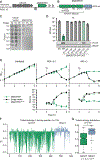Bacterial NLR-related proteins protect against phage
- PMID: 37160116
- PMCID: PMC10294775
- DOI: 10.1016/j.cell.2023.04.015
Bacterial NLR-related proteins protect against phage
Abstract
Bacteria use a wide range of immune pathways to counter phage infection. A subset of these genes shares homology with components of eukaryotic immune systems, suggesting that eukaryotes horizontally acquired certain innate immune genes from bacteria. Here, we show that proteins containing a NACHT module, the central feature of the animal nucleotide-binding domain and leucine-rich repeat containing gene family (NLRs), are found in bacteria and defend against phages. NACHT proteins are widespread in bacteria, provide immunity against both DNA and RNA phages, and display the characteristic C-terminal sensor, central NACHT, and N-terminal effector modules. Some bacterial NACHT proteins have domain architectures similar to the human NLRs that are critical components of inflammasomes. Human disease-associated NLR mutations that cause stimulus-independent activation of the inflammasome also activate bacterial NACHT proteins, supporting a shared signaling mechanism. This work establishes that NACHT module-containing proteins are ancient mediators of innate immunity across the tree of life.
Keywords: NACHT; NLR; STAND; bacteriophage; inflammasome; innate immunity; phage defense.
Copyright © 2023 Elsevier Inc. All rights reserved.
Conflict of interest statement
Declaration of interests The authors declare no competing interests.
Figures







Comment in
-
Immunology: NACHT domain proteins get a prokaryotic origin story.Curr Biol. 2023 Aug 21;33(16):R875-R878. doi: 10.1016/j.cub.2023.06.084. Curr Biol. 2023. PMID: 37607487
References
Publication types
MeSH terms
Substances
Grants and funding
LinkOut - more resources
Full Text Sources
Molecular Biology Databases

